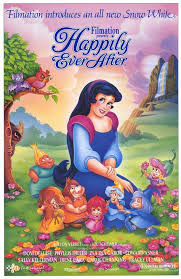
Snow White and the Seven Dwarfs is a 1937 American animated musical fantasy film produced by Walt Disney Productions and originally released by RKO Radio Pictures. Based on the 1812 German fairy tale by the Brothers Grimm, it is the first full-length cel animated feature film and the earliest Disney animated feature film. The story was adapted by storyboard artists Dorothy Ann Blank, Richard Creedon, Merrill De Maris, Otto Englander, Earl Hurd, Dick Rickard, Ted Sears and Webb Smith. David Hand was the supervising director, while William Cottrell, Wilfred Jackson, Larry Morey, Perce Pearce, and Ben Sharpsteen directed the film's individual sequences.
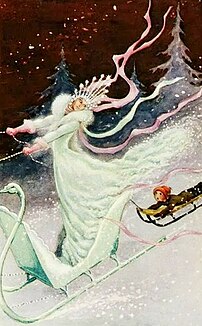
"The Snow Queen" is an original fairy tale by Danish author Hans Christian Andersen. It was first published 21 December 1844 in New Fairy Tales. First Volume. Second Collection. 1845. The story centres on the struggle between good and evil as experienced by Gerda and her friend, Kai.
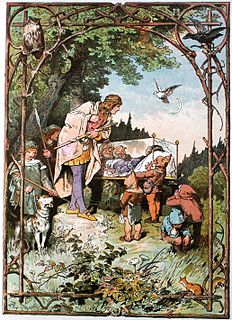
"Snow White" is a 19th-century German fairy tale that is today known widely across the Western world. The Brothers Grimm published it in 1812 in the first edition of their collection Grimms' Fairy Tales and numbered as Tale 53. The original German title was Sneewittchen, a Low German form, but the first version gave the High German translation Schneeweißchen, and the tale has become known in German by the mixed form Schneewittchen. The Grimms completed their final revision of the story in 1854.

"Sleeping Beauty", or "Little Briar Rose", also titled in English as "The Sleeping Beauty in the Woods", is a classic fairy tale about a princess who is cursed to sleep for a hundred years by an evil fairy, to be awakened by a handsome prince at the end of them. The good fairy, realizing that the princess would be frightened if alone when she awakens, uses her wand to put every living person and animal in the palace asleep, to awaken when the princess does.
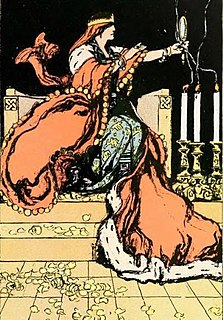
The Evil Queen, also called the Wicked Queen, is a fictional character and the main antagonist of "Snow White", a German fairy tale recorded by the Brothers Grimm; similar stories are also known to exist in other countries. Other versions of the Queen appear in "Snow White" derivative works, and the character has also become an archetype for unrelated works of fiction.

The 10th Kingdom is an American fairytale fantasy miniseries written by Kathryn Wesley and produced by Britain's Carnival Films, Germany's Babelsberg Film und Fernsehen, and the US's Hallmark Entertainment. It depicts the adventures of a young woman and her father after they are transported from New York City, through a magical mirror, into a parallel world of fairy tales.

Adriana Caselotti was an American actress, voice actress, and singer. Caselotti was the voice of the title character of the first Walt Disney animated feature Snow White and the Seven Dwarfs, for which she was named as a Disney Legend in 1994, making her the first female voice actor so named.
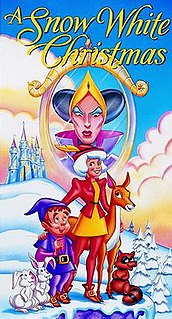
A Snow White Christmas is a Christmas animated television special produced by Filmation and telecast December 19, 1980, on CBS. The special is a sequel to the fairy tale "Snow White", unrelated to Filmation's other sequel to "Snow White" titled Happily Ever After (1990).

Snow White's Scary Adventures is a dark ride at the Disneyland, Tokyo Disneyland, and Disneyland Park (Paris) theme parks, and formerly at the Magic Kingdom. Located in Fantasyland, it is one of the few remaining attractions that was operational on Disneyland's opening day in 1955. The ride's story is based on Disney's 1937 film, Snow White and the Seven Dwarfs, their first animated feature film.

Snow White: The Fairest of Them All is a 2001 fantasy adventure television film co-written and directed by Caroline Thompson and produced by Hallmark Entertainment. The film was first released theatrically in Europe, and subsequently aired in the United States on ABC as part of their series on The Wonderful World of Disney on March 17, 2002.
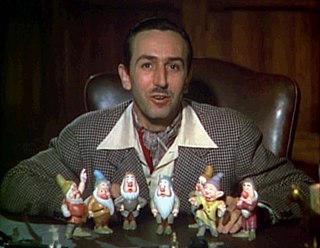
The Seven Dwarfs are a group of seven fictional dwarfs each with an age above 100 years old that appear in the fairy tale Snow White and others.

Happily N'Ever After 2: Snow White—Another Bite at the Apple is a 2009 American-German computer-animated direct-to-video film and sequel to Happily N'Ever After released on DVD on March 24, 2009, which stars Helen Niedwick, Cam Clarke, Jim Sullivan, Kirk Thornton, Cindy Robinson, David Lodge, and Catherine Lavin. Mambo, Munk, Little Red Riding Hood, Rumpelstiltskin, the Fairy Godmother, and the Dwarves are the only characters to return from the first film.

Snow White is a fictional character and a main character from Walt Disney Productions' first animated feature film Snow White and the Seven Dwarfs (1937). The character of Snow White was derived from a fairy tale known from many countries in Europe, the best-known version being the one collected by the Brothers Grimm.
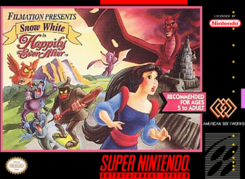
Snow White: Happily Ever After is a North America-exclusive video game that was released in 1994 for the Super Nintendo Entertainment System. The game was targeted for female video game players. It is based on the 1990 animated Filmation movie Happily Ever After, and not the 1937 Disney film.
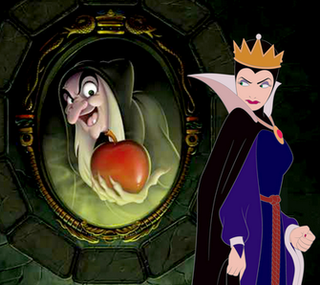
The Evil Queen, also known as the Wicked Queen or just the Queen, and sometimes instead identified by her given name as Queen Grimhilde, is a fictional character who appears in Walt Disney Productions' first animated feature film Snow White and the Seven Dwarfs (1937) and a villain character in the extended Disney's Snow White franchise. She is based on the Evil Queen character from the German fairy tale "Snow White".
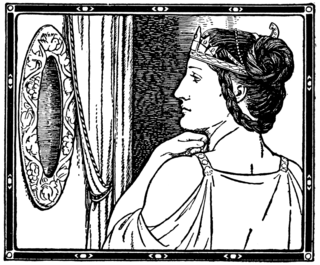
The Magic Mirror is a mystical object that is featured in the story of Snow White, depicted as either a hand mirror or a wall-mounted mirror.
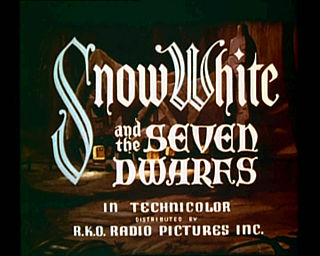
Snow White is a Disney media franchise that began in 1937 with the theatrical release of Snow White and the Seven Dwarfs. It is based on the 1812 fairy tale by the Brothers Grimm.
The King is a character in Snow White.

Snow White and the Seven Dwarfs is a 1938 picture book written and illustrated by Wanda Gág and published by Coward-McCann. Snow White and the Seven Dwarfs was a Caldecott Medal Honor Book in 1939. The book is a twist on the classic tale of Snow White by the Brothers Grimm. Since then it has been republished several times, including in 1999, 2004, and 2013.
Revolting Rhymes is a 2016 British-German computer animated TV film based on the 1982 book of the same name written by Roald Dahl and illustrated by Quentin Blake.
